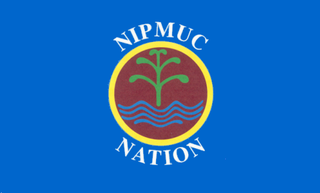
The Schaghticoke are a Native American tribe of the Eastern Woodlands who historically consisted of Mahican, Potatuck, Weantinock, Tunxis, Podunk, and their descendants, peoples indigenous to what is now New York, Connecticut, and Massachusetts. The remnant tribes amalgamated in the area near the Connecticut-New York border after many losses, including the sale of some Schaghticoke and members of neighboring tribes into slavery in the Caribbean in the 1600s.

The Occaneechi Band of the Saponi Nation is a state-recognized tribe in North Carolina.
State-recognized tribes in the United States are organizations that identify as Native American tribes or heritage groups that do not meet the criteria for federally recognized Indian tribes but have been recognized by a process established under assorted state government laws for varying purposes or by governor's executive orders. State recognition does not dictate whether or not they are recognized as Native American tribes by continually existing tribal nations.

The Nipmuc Nation was a non profit entity of the state-recognized tribe Hassanamisco Nipmuc, an Indigenous people of the Northeastern Woodlands based in South Grafton, Massachusetts.
The Brothertown Indians, located in Wisconsin, are a possible Native American tribe formed in the late 18th century from communities of so-called "praying Indians", descended from Christianized Pequot, Narragansett, Montauk, Tunxis, Niantic, and Mohegan (Algonquian-speaking) tribes of southern New England and eastern Long Island, New York. In the 1780s after the American Revolutionary War, they migrated from New England into New York state, where they accepted land from the Iroquois Oneida Nation in Oneida County.

The Native American tribes in Virginia are the Indigenous peoples whose tribal nations historically or currently are based in the Commonwealth of Virginia in the United States of America.
The Duwamish Tribe, officially known as the Duwamish Tribal Organization, is a cultural heritage organization of individuals who identify as descendants of the Duwamish people, based in Seattle, Washington.
The MOWA Band of Choctaw Indians is a state-recognized tribe, located in southwest Alabama, with a population largely based in southern Washington County and some membership in northern Mobile County.
The Advisory Council on California Indian Policy (ACCIP) was created by an act of the United States Congress and signed by President George H. W. Bush on October 14, 1992. It provided for the creation of a special advisory council made up of eighteen members with the purpose of studying the unique problems that California Native Americans face in receiving federal acknowledgment. Additionally, they were given the task of studying the social and economic conditions of California natives, “characterized by, among other things, alcohol and substance abuse, critical health problems, family violence and child abuse, lack of educational and employment opportunities, and significant barriers to tribal economic development.” Under the provisions for the act, the Advisory Council was to make recommendations regarding California Indian policy to the Congress and the Departments of the Interior and of Health and Human Services.
The Lower Muskogee Creek Tribe (East of the Mississippi), also known as the Lower Muskogee Creek Tribe, is a state-recognized tribe in Georgia. The organization was denied federal recognition in 1981.
The Nulhegan Band of the Coosuk Abenaki Nation is a state-recognized tribe and nonprofit organization, called AHA "Abenaki Helping Abenaki", whose headquarters and land are based in Vermont. They are often referred to as the Nulhegan Abenaki Tribe or simply, Nulhegan.
The Cherokee Tribe of Northeast Alabama (CTNEAL), formerly the Cherokees of Jackson County, is a state-recognized tribe in Alabama. They have about 3,000 members. The tribe has a representative on the Alabama Indian Affairs Commission and the Inter-Tribal Council of Alabama. They are not federally recognized as a Native American tribe.
The Choctaw-Apache Community of Ebarb, also known as the Choctaw-Apache Tribe of Ebarb, is a state-recognized tribe and nonprofit organization in Louisiana. The community describes themselves as the descendants of Choctaw and Lipan Apache people and is primarily based in the town of Zwolle, Louisiana, with powwow grounds in Ebarb, Louisiana, both of which are in Sabine Parish, Louisiana, where the group say they have lived since the early 18th century.
Pointe-au-Chien Tribe is a State-recognized Native American Tribe, located in Terrebonne and Lafourche Parishes, Louisiana. Pointe-au-Chien Tribe claim to be descendants of the Chitimacha; they are also believed to be descendants of other historical tribes located in the region, notably the Acolapissa, Atakapas, coastal Choctaw and Biloxi Indians. The Tribe has approximately 800 members. In 1996, they have petitioned to the United States Bureau of Indian Affairs for federal recognition.

The Coharie Intra-tribal Council, Inc. is a state-recognized tribe in North Carolina. The headquarters are in Clinton, North Carolina.
The Missisquoi Abenaki Tribe is one of four state-recognized tribes in Vermont, who claim descent from Abenaki people. The Missisquoi Abenaki Tribe specifically claims descent from the Missiquoi people.

The Sappony are a state-recognized tribe in North Carolina. They claim descent from the historic Saponi people, an Eastern Siouan language-speaking tribe who occupied the Piedmont of North Carolina and Virginia.
The Accohannock Indian Tribe, Inc. is a state-recognized tribe in Maryland and a nonprofit organization of individuals who identify as descendants of the Accohannock people.





